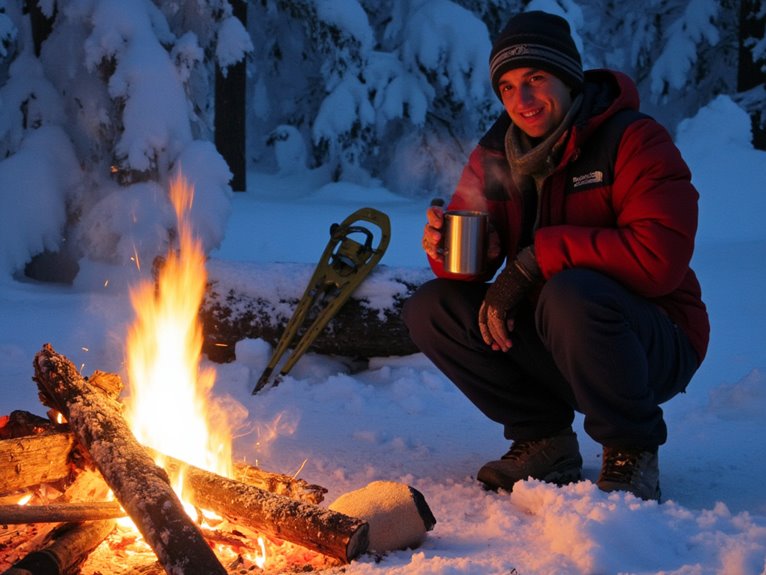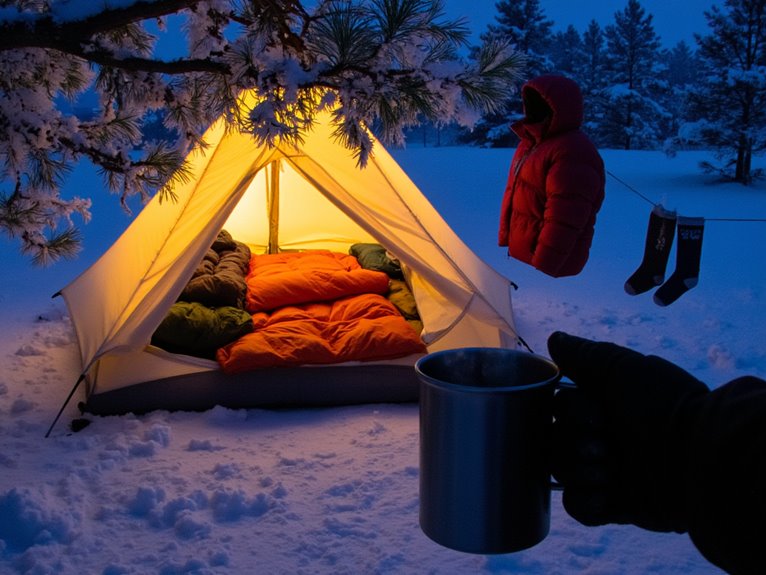Tips for Staying Warm During Cold-Weather Camping
For cold-weather camping, you’ll need a three-layer clothing system with moisture-wicking base layers, insulating mid-layers, and waterproof shells-avoid cotton entirely. Your sleep system requires a winter-rated sleeping bag and insulated pad with R-value 5 or higher to prevent ground heat loss. Select campsites with solar exposure while avoiding valleys where cold air settles. Pack essential safety gear including emergency blankets, first aid supplies, and communication devices. These fundamentals form the foundation for advanced winter survival techniques.
We are supported by our audience. When you purchase through links on our site, we may earn an affiliate commission, at no extra cost for you. Learn more. Last update on 5th January 2026 / Images from Amazon Product Advertising API.
Notable Insights
- Layer clothing with moisture-wicking base layers, insulating mid-layers, and waterproof outer shells while avoiding cotton entirely.
- Use a winter-rated sleeping bag with an insulated pad having an R-value of 5 or higher.
- Select campsites with solar exposure and natural windbreaks while avoiding valleys where cold air settles.
- Maintain proper ventilation when using combustion-based heaters to prevent dangerous carbon monoxide buildup in enclosed spaces.
- Stay hydrated with warm liquids and recognize hypothermia symptoms like shivering, confusion, and slurred speech.
Essential Clothing and Gear Selection for Cold Weather
When temperatures drop below freezing, your clothing and gear selection becomes the primary barrier between comfort and hypothermia. Start with moisture-wicking baselayers made from merino wool or synthetic fabrics. These clothing materials prevent sweat from cooling your skin during activity.
Proper baselayers form your first line of defense against hypothermia when winter temperatures become life-threatening.
Your gear layering system requires three distinct components. Add an insulating mid-layer like fleece or down for heat retention. Down provides superior warmth-to-weight ratios in dry conditions.
Top this with a windproof, waterproof outer shell that maintains breathability while blocking weather elements. Wind significantly affects how cold you feel, as it can make temperatures seem much lower than the actual reading and penetrate through wind chill effects.
Don’t neglect extremities. Pack extra socks, liner gloves, and insulated headwear. Your head loses significant heat, making quality beanies essential. Choose insulated winter boots with moisture resistance for packed snow conditions.
Avoid cotton entirely-it retains moisture and accelerates heat loss. For extreme cold camping down to -30°F conditions, consider fleece-lined thermal underwear as your base layer for maximum insulation. Ensure all layers fit loosely for circulation to maintain proper blood flow and maximize warmth retention.
Creating a Warm and Comfortable Sleep System
Your sleep system forms the foundation of cold-weather camping comfort and requires three critical components working together.
You’ll need a winter-rated sleeping bag matched to expected temperatures, a high R-value insulated pad to prevent ground heat loss, and effective moisture management to control tent condensation. For extreme conditions, consider stacking multiple sleeping bags to achieve thermal performance down to approximately -35°C. Understanding your personal physiological traits helps determine which gear combinations will work best for your unique warmth retention needs.
Look for sleeping bags with dual side zippers which provide better ventilation control and easier entry while maintaining thermal efficiency in fluctuating nighttime temperatures.
Getting these elements right means the difference between restful sleep and a miserable night fighting hypothermia risk.
Winter Sleeping Bag Selection
Selecting the right sleeping bag forms the foundation of any effective winter sleep system, but temperature ratings alone don’t tell the complete story. You’ll need to understand EN ratings, which provide scientific Lower (male) and Comfort (female) temperature limits. Choose bags rated 10-15°F below your expected sleeping temperatures for adequate warmth margins.
When comparing sleeping bag types, mummy shapes minimize heat loss through reduced air space, while rectangular designs sacrifice warmth for comfort.
For insulation materials, down offers superior warmth-to-weight ratios and compressibility but fails when wet. Synthetic insulation maintains performance in moisture but weighs more. Look for 700+ fill power down in winter bags.
Essential features include insulated hoods, zipper draft tubes, and water-resistant shells to maximize thermal efficiency.
Insulating Sleep Pad Setup
Even the warmest sleeping bag won’t protect you from the ground’s relentless cold without proper insulation beneath your body. You need an R-value of 5 or higher for winter camping.
Pad layering achieves this effectively-place a closed-cell foam pad as your base layer, then add an insulated inflatable pad on top. This combination blocks ground cold while maximizing comfort.
Choose pads that cover your full body length, from shoulders to feet. Regular pads measure 72 inches, while long pads extend to 78 inches. Wider options at 25-30 inches reduce heat loss from movement.
Material technologies like reflective layers and synthetic insulation enhance warmth retention. Inflate pads fully to maintain designed insulation properties.
Secure them inside your tent to prevent shifting and exposure to cold ground patches.
Managing Tent Condensation
When moisture from your breath and body heat meets cold tent surfaces, condensation forms and can drench your gear while making sleep miserable.
Double-wall tents greatly reduce this problem by separating the wet rainfly from your inner mesh tent. Single-wall designs trap moisture directly against tent walls.
Effective ventilation techniques require opening vents and mesh windows to create cross-breezes that prevent humid air from stagnating.
Keep adjustable rainfly vents partially open even during storms.
Never completely seal your tent overnight.
Proper humidity management means avoiding moisture sources inside your shelter.
Don’t cook or dry wet clothes inside.
Limit occupants to reduce breath-generated moisture.
Wipe down interior surfaces regularly and position sleeping areas away from walls where condensation forms most readily.
Heat Sources and Fire Safety in Winter Conditions
Five primary heat sources can keep you warm during winter camping, each with distinct safety requirements and operational considerations.
Portable diesel heaters offer energy-efficient operation on diesel or kerosene with consistent temperature control.
Propane heaters provide widely available fuel and easy operation but require proper ventilation due to combustion fumes.
Electric heaters deliver clean, fume-free heat when you’ve got shore power or large generators available.
Wood and charcoal stoves generate radiant heat but demand careful handling to prevent carbon monoxide poisoning.
Essential fire safety measures include maintaining ventilation by cracking windows or vents, clearing flammable materials from heater areas, and never leaving heat sources unattended.
Install carbon monoxide detectors for combustion-based heat source options.
Keep fire extinguishers accessible and store fuel safely away from heat sources.
Maintaining Body Temperature Through Activity and Nutrition

Beyond external heat sources, your body’s internal furnace requires proper fuel and activation to generate heat throughout cold camping conditions.
Activity strategies center on moderate movement like hiking or camp setup to boost metabolism and prevent blood pooling. Avoid extended inactivity, which increases hypothermia risk. Don’t overexert yourself-excessive sweating leads to dangerous heat loss when moisture cools.
Nutrition tips emphasize increased caloric intake to fuel heightened metabolism. Focus on fats and carbohydrates as primary energy sources.
Consume frequent small meals to maintain steady internal heat production. Include warm, high-calorie liquids such as soups for simultaneous hydration and warming.
Plan easy-to-prepare meals requiring minimal energy expenditure when cooking becomes challenging in harsh conditions. Consider timing your food preparation during holiday sale season when camping gear and portable cooking equipment are often available at discounted prices.
Strategic Campsite Selection and Tent Setup
While your body generates internal heat through activity and nutrition, your tent’s location determines whether that warmth gets preserved or stolen by environmental factors.
Proper campsite orientation maximizes solar exposure during daylight hours while positioning your tent’s narrow end toward prevailing winds to reduce heat loss. Avoid valleys where cold air settles and choose sites with natural windbreaks like dense trees or rock formations.
Strategic tent positioning with narrow end facing prevailing winds and natural windbreaks maximizes solar gain while minimizing dangerous heat loss.
Thorough terrain inspection prevents dangerous mistakes. Probe snow depth with hiking poles to identify hidden obstacles or air pockets before setup. Pack down snow using boots or snowshoes, then allow the platform to set for 30 minutes.
Maintain 200 feet distance from water sources to prevent ground moisture issues. Clear dead branches overhead and dig your sleeping area slightly lower than surrounding snow for enhanced insulation and stability.
Safety Preparation and Emergency Protocols
When temperatures drop below freezing, your margin for error shrinks dramatically, making thorough safety preparation the difference between a memorable adventure and a life-threatening emergency.
Pack essential gear including waterproof matches, emergency blankets, and an extensive first aid kit with cold-weather medications. Your emergency signaling equipment must include a whistle and high-lumen flashlight for low-visibility conditions.
Critical safety protocols include:
- Recognizing hypothermia symptoms – shivering, confusion, and slurred speech demand immediate warming action
- Maintaining communication – inform contacts of your route and carry charged devices or satellite messengers
- Establishing proper hydration methods – use insulated bottles and warm liquids to prevent dehydration
Remove wet clothing before sleeping and store damp items inside your sleeping bag near your torso for overnight drying using body heat.
Consider bringing a waterproof safe to protect essential documents like permits, emergency contact information, and insurance cards from moisture damage during extended cold-weather expeditions.
On a final note
You’ll stay warm and safe during cold-weather camping by implementing these core strategies. Proper layering systems and quality gear form your primary defense against hypothermia. Your sleep system requires a rated sleeping bag, insulated pad, and appropriate shelter. Maintain caloric intake above 4,000 calories daily and stay hydrated. Select windproof campsites with natural barriers. Always carry emergency signaling devices and inform others of your planned route before departure.

